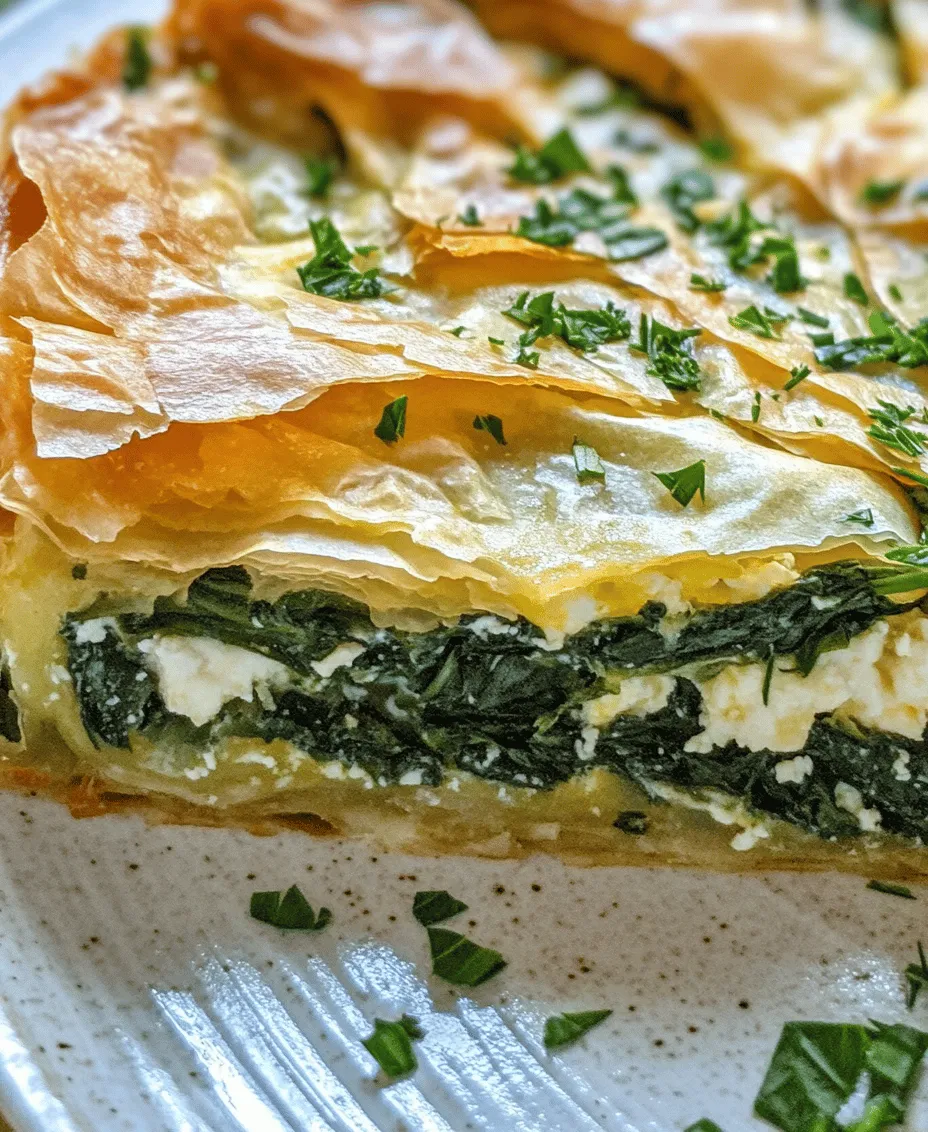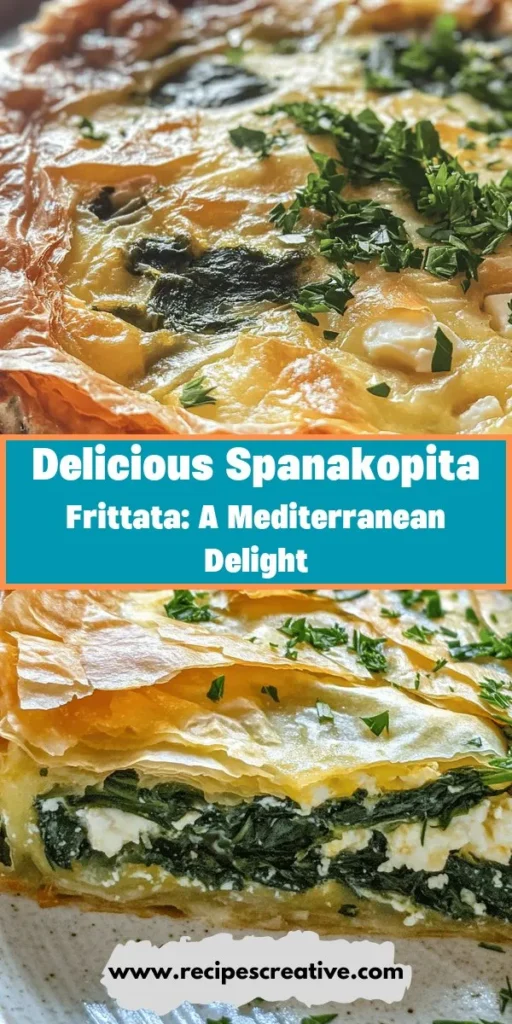Introduction
Spanakopita, a traditional Greek dish, has captured the hearts and palates of food lovers around the world. This savory pastry, filled with fresh spinach and creamy feta cheese, wrapped in layers of crispy phyllo dough, is a staple in Greek cuisine. Its rich flavors and delightful textures not only showcase the beauty of Mediterranean cooking but also signify the importance of fresh ingredients and traditional methods passed down through generations. For those seeking a delicious twist on this classic dish, the Spanakopita Frittata offers a modern, easy-to-make alternative that beautifully combines the beloved flavors of Spanakopita with the simplicity of a frittata.
The frittata, often referred to as an Italian-style omelet, is a versatile egg dish that can be enjoyed at any meal of the day. Its ability to incorporate a variety of ingredients makes it an excellent choice for using up leftovers or seasonal produce while providing a hearty, satisfying meal. The Spanakopita Frittata, with its vibrant greens and tangy feta, is not only delightful to the taste buds but also presents a plethora of health benefits, making it a nutritious option for breakfast, brunch, or a light dinner.
Packed with vitamins and minerals from spinach, along with the rich, creamy flavor of feta cheese, this frittata serves as a power-packed dish that nourishes the body and pleases the palate. Whether you are a seasoned cook or a novice in the kitchen, this recipe promises to deliver a delicious meal that is both simple to prepare and impressive in presentation. Let’s dive in to explore the cultural significance of Spanakopita and how you can create this delightful frittata at home.
Understanding Spanakopita
The origins of Spanakopita date back to ancient Greece, where the use of phyllo dough in cooking became prevalent. This dish is a testament to the agricultural bounty of the region, particularly the abundance of fresh greens, which have long been a staple in the Mediterranean diet. Traditionally, Spanakopita consists of a filling made from fresh spinach, herbs, and feta cheese, encased in layers of flaky phyllo pastry. The combination of textures—from the crisp exterior to the soft, flavorful filling—creates a dish that is both visually appealing and satisfying.
In Greek culture, Spanakopita is often served at celebrations, family gatherings, and as part of the meze platter, which features a variety of small dishes shared among guests. It highlights the Mediterranean philosophy of communal dining, where food is not just sustenance but a means of bringing people together. The dish has also seen various adaptations over the years, with some recipes incorporating other greens like leeks or chard, and others experimenting with different types of cheese. Each variation reflects the regional ingredients and personal preferences of the cook, making Spanakopita a versatile and beloved dish.
The appeal of Spanakopita lies not only in its flavor but also in its health benefits. Spinach is a nutrient-dense green, rich in vitamins A, C, and K, as well as iron and calcium. Feta cheese, while providing a creamy texture and distinct taste, also contributes calcium and protein, making this dish a nourishing option. In recent years, Spanakopita has gained popularity beyond Greek borders, inspiring chefs and home cooks alike to explore its flavors and incorporate them into modern meals, such as the Spanakopita Frittata.
What is a Frittata?
A frittata is an Italian egg dish that is similar to an omelet but differs significantly in preparation and presentation. While an omelet is typically cooked on the stovetop and folded over, a frittata is cooked slowly over low heat and often finished in the oven, allowing the eggs to set evenly throughout. This method results in a thick, hearty dish that can be packed with various ingredients, ranging from vegetables and meats to cheeses and herbs.
One of the standout features of frittatas is their versatility. They are perfect for using up leftover ingredients or seasonal vegetables, making them an ideal choice for meal prep. You can mix and match flavors according to your preferences, ensuring that each frittata is unique and tailored to your taste. This flexibility makes frittatas a favorite for brunch gatherings, where they can be sliced into wedges and served alongside a fresh salad or crusty bread.
Moreover, frittatas are not only easy to prepare but also make for a stunning presentation. Their vibrant colors and varied textures can elevate the dining experience, whether for a casual meal or a special occasion. As a bonus, they can be enjoyed hot or at room temperature, making them a convenient option for entertaining or taking on the go. The Spanakopita Frittata, with its combination of spinach, feta, and aromatic ingredients, is a perfect example of how to transform a traditional dish into a delightful frittata that everyone will love.
Key Ingredients for Spanakopita Frittata
To create a delicious Spanakopita Frittata, it’s essential to understand the key ingredients and their roles in the recipe. Each component not only contributes to the flavor but also packs a nutritional punch, making this dish a wholesome choice.
Eggs
At the heart of any frittata are the eggs, which serve as the main ingredient and provide a rich source of protein. Eggs are incredibly versatile and can enhance the texture of the dish, creating a custard-like consistency when cooked properly. In this recipe, the eggs hold together the filling of spinach and feta, ensuring every bite is flavorful and satisfying.
Spinach
Spinach is a powerhouse of nutrients, loaded with vitamins A, C, and K, as well as minerals like iron and calcium. Its mild flavor makes it a perfect base for the frittata, complementing the salty feta and aromatic ingredients. Additionally, spinach is low in calories and high in fiber, making it an excellent choice for those looking to maintain a healthy diet. Utilizing fresh spinach not only enhances the taste but also adds vibrant green color to the dish.
Feta Cheese
Feta cheese is a key ingredient that brings a tangy and creamy element to the Spanakopita Frittata. This crumbly cheese is traditionally made from sheep or goat milk and is rich in flavor, adding depth to the dish. Feta is also a good source of calcium, which is important for bone health, and it provides protein, making the frittata more filling. The combination of spinach and feta captures the essence of Spanakopita, allowing you to enjoy its flavors in a new form.
Onion and Garlic
Onion and garlic are aromatic ingredients that elevate the overall flavor profile of the frittata. Sautéing these ingredients before adding them to the egg mixture releases their natural sweetness and adds a savory depth to the dish. Both onion and garlic are known for their health benefits, including anti-inflammatory properties and immune-boosting effects, making them a valuable addition to this recipe.
In summary, the Spanakopita Frittata combines the beloved flavors of traditional Spanakopita with the convenience and versatility of a frittata. With nutritious ingredients like eggs, spinach, feta, onion, and garlic, this dish is not only easy to prepare but also a delightful way to enjoy a healthy meal. As we move forward, we will explore the step-by-step instructions to create your own Spanakopita Frittata, ensuring that you can bring this delicious recipe to your table with ease.

Fresh Herbs for Added Freshness
To elevate the flavor profile of your Spanakopita Frittata, fresh herbs play a crucial role. Adding fresh parsley not only enhances the dish’s taste but also brings a vibrant pop of color to your frittata. Parsley is known for its bright, slightly peppery flavor that complements the earthiness of spinach and the saltiness of feta cheese. You can finely chop a handful of fresh parsley and fold it into the egg mixture just before cooking, ensuring that the herb’s freshness remains intact. If you’re feeling adventurous, consider incorporating other herbs like dill or mint, both of which are traditional in Greek cuisine and pair beautifully with the ingredients in this dish.
Optional Ingredients for Texture Enhancement
For those looking to add an extra layer of texture and richness to the frittata, optional ingredients such as phyllo dough and melted butter can be included. Phyllo dough, when brushed with melted butter and layered at the bottom of your baking dish, creates a crispy, flaky base that contrasts wonderfully with the soft, custardy frittata. Simply layer several sheets of phyllo, brushing each layer with melted butter before adding the egg mixture on top. This technique not only adds a delightful crunch but also gives a nod to traditional Spanakopita, making your frittata even more delicious.
Step-by-Step Instructions
Step 1: Preheat the Oven
Start by preheating your oven to 375°F (190°C). A properly preheated oven is crucial for even cooking and browning. This temperature ensures that the frittata cooks through without becoming dry, allowing the flavors to meld beautifully.
Step 2: Sautéing Vegetables
While the oven is preheating, heat a couple of tablespoons of olive oil in a large, oven-safe skillet over medium heat. Add the chopped onions and sauté for about 3-4 minutes, until they become translucent. Next, add the minced garlic and sauté for an additional minute. The goal here is to enhance the flavors of the vegetables. Ensure that they are cooked just enough to release their natural sweetness, without browning them too much.
Once the onions and garlic are ready, add the fresh spinach. Cook the spinach until wilted, about 2-3 minutes. This step is vital as it reduces the moisture content of the spinach, preventing your frittata from becoming soggy.
Step 3: Mixing the Egg Base
In a large mixing bowl, crack 6 large eggs and whisk them together thoroughly until the yolks and whites are completely combined. To achieve a fluffy texture, incorporate a splash of milk or cream into the eggs—about a quarter cup should suffice. Season with salt and pepper to taste, and fold in the crumbled feta cheese and chopped parsley. The feta adds a creamy tanginess that beautifully complements the spinach.
Step 4: Combining the Mixtures
Once your egg mixture is ready, it’s time to combine it with the sautéed vegetables. Pour the egg mixture over the sautéed spinach and onions in the skillet, ensuring an even distribution. Gently stir to combine, taking care not to break up the feta too much. This is a crucial step as it allows the spinach and egg to meld, ensuring that every bite is flavorful without losing moisture.
Step 5: Cooking Techniques on the Stovetop
Before transferring the skillet to the oven, cook the frittata on the stovetop over medium-low heat for about 5-7 minutes. This initial cooking helps set the bottom of the frittata, preventing it from sticking and ensuring even cooking. You’ll notice the edges starting to firm up while the center remains slightly jiggly.
Step 6: Baking for Perfect Doneness
Carefully transfer the skillet to your preheated oven. Bake for an additional 15-20 minutes, or until the frittata is puffed and golden brown on top. For the best results, monitor the cooking time closely. You can check for doneness by inserting a knife in the center; if it comes out clean, your frittata is ready.
Serving Suggestions and Pairings
Spanakopita Frittata can be enjoyed warm, at room temperature, or even chilled. It’s an incredibly versatile dish suitable for breakfast, brunch, lunch, or dinner. Here are some serving suggestions:
– Brunch Spread: Serve your frittata as part of a larger brunch spread alongside fresh fruit, yogurt, and pastries. This combination provides a well-rounded meal that your guests will love.
– Salad Options: Pair the frittata with a light salad. A simple arugula salad dressed with lemon vinaigrette or a Greek salad with tomatoes, cucumbers, olives, and feta can provide a refreshing contrast to the frittata’s richness.
– Dips and Spreads: Consider serving tzatziki on the side for a cool, creamy dip that enhances the Mediterranean flavors of the frittata.
– Beverage Pairings: For beverages, opt for a light white wine such as Sauvignon Blanc, a refreshing iced tea, or even a robust coffee to complement the flavors of the dish.
Storage and Reheating Tips
If you have leftovers (which is rare, but possible!), proper storage will help maintain the frittata’s freshness. Here are some best practices:
– Storing Leftovers: Allow the frittata to cool completely before transferring it to an airtight container. It can be stored in the refrigerator for up to 3-4 days. If you prefer, you can also slice it into individual portions for easier reheating.
– Reheating Methods: To reheat the frittata without drying it out, place a slice in the microwave for about 30-45 seconds, covering it with a damp paper towel. Alternatively, you can reheat individual slices in a skillet over low heat, adding a splash of water and covering it with a lid to create steam.
– Creative Repurposing: Leftover frittata can be creatively repurposed. Consider crumbling it over a salad, using it as a filling for a wrap, or serving it alongside roasted vegetables for a quick weeknight dinner.
Conclusion
The Spanakopita Frittata is a delightful and versatile dish that beautifully combines the flavors of spinach and feta, all wrapped in a fluffy egg base. Whether served for breakfast, brunch, or a light dinner, this dish is sure to impress family and friends with its wholesome ingredients and vibrant taste.
Encouraging readers to try their hand at this frittata, it’s a wonderful way to explore Mediterranean flavors while enjoying the joy of cooking. Plus, its adaptability means you can easily customize it with your favorite ingredients or whatever you have on hand. So gather your ingredients, follow the steps, and enjoy the satisfaction of creating a delicious meal to share with loved ones. Cooking is not just about the food; it’s about the memories you create and the joy of sharing wholesome meals with those dear to you.



